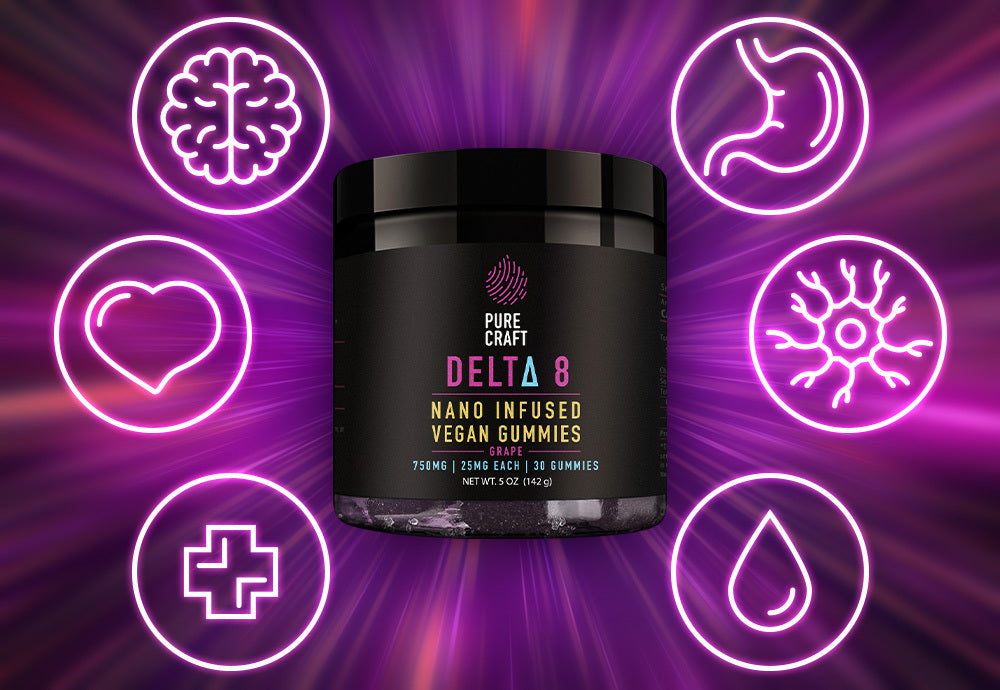Your Cart is Empty
FREE SHIPPING ON ORDERS $70+ | SATISFACTION GUARANTEED
Delta-8 is a naturally-occurring compound. But it can also be created by people. In this quick post, we’re breaking down scientific barriers — explaining in everyday terms how cannabis processors create D8 in a lab or manufacturing setting.
Delta-8-THC (commonly called delta-8 or D8) is a mildly psychoactive cannabinoid found in both industrial hemp and marijuana. Its chemical structure is very similar to delta-9-THC (what most people think of and refer to as plain ol’ “THC”). But, it’s a separate and distinct cannabinoid with its own unique properties.
For a thorough explainer on delta-8, check out our post entitled Delta-8-THC: What It Is, Where It Comes From, How It Differs From CBD & Delta-9-THC.

It may sound cray cray to create delta-8 when it’s already generated by nature and already right there in the cannabis plant.
Here’s the deal, though. The amount of D8 that’s inherent to cannabis is in such minute quantities that it’s not economical to use. You’d have to grow so much cannabis to get a usable amount of delta-8 — the numbers just don’t work out from a business or agricultural perspective.
Luckily, it’s pretty easy and very affordable to mass produce substantial quantities of D8 in a lab or processing plant. Delta-8-THC can be made from the crops growers already have on hand. Plus, the amount of delta-8 humans can get from each cannabis plant is significantly greater than what nature is able to yield.
Thanks to the 2018 Farm Bill, industrial hemp and its byproducts — like CBD — that contain no more than 0.3% THC are federally legal in the US. This means that hemp and hemp-derived CBD are abundant, affordable, and OK to sell to eager consumers.
And as such, every day the infrastructure to farm, transport, transform, and market hemp and CBD oil products is expanding and solidifying. Seriously, have you noticed the explosion in CBD retailers and infused goods out there?!
For the same reasons, hemp CBD is an ideal input for making delta-8-THC.
In the beginning, all cannabinoids start out as cannabigerolic acid (CBGA). As the cannabis plant grows, various influences convert the CBGA molecules into the lineup of cannabinoids we all know and love. Moreover, nature-made delta-8-THC is formed when delta-9-THC degrades over time.
This is an important fundamental concept to keep in mind: Cannabinoids are naturally morphable. They’re born changelings! It’s their MO to evolve, whether the nudge to do so comes organically or from a guy in a lab coat.
There are a few ways to transform the chemical structure of CBD into that of D8. The well-established technique below is probably the most common because it’s easy, quick, uses readily available materials, and is cost effective. It’s not magic — just the result of smart and industrious pros!
This is a basic how-to. Actual outcomes will vary by producer since they likely use different solvents, acids, cleansing solutions, process variations, etc.
Hemp-derived CBD can be converted into delta-8-THC through a relatively simple process. Product makers do this because D8 doesn’t naturally occur in cannabis in large enough amounts to be commercially profitable. Making delta-8 in a lab is an easy and cost-effective alternative.
GET YOUR HEMP-CBD-DERIVED DELTA-8 NOW
References

The cannabis compound CBD has been popping up in Parkinson’s disease (PD) therapy and prevention conversations, propelled by success stories from p...
Read More
CBD is one of the most popular supplements on the market today. But you're a savvy consumer. You know just because something is popular doesn’t mea...
Read More
You know delta-8 as "weed-lite" or the "chillest of the cannabinoids." But what about all the potential health benefits of this unique compound? Wh...
Read More